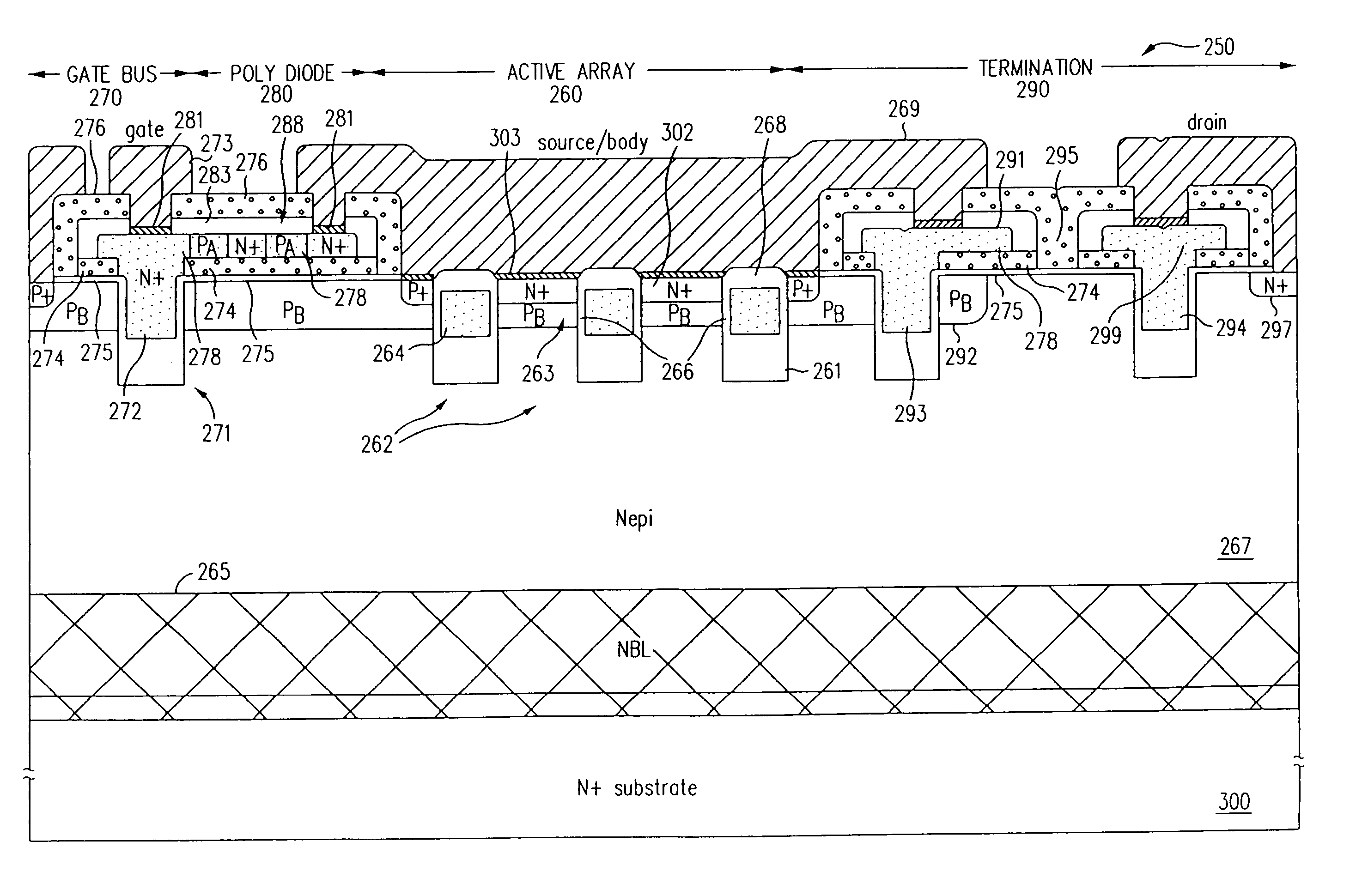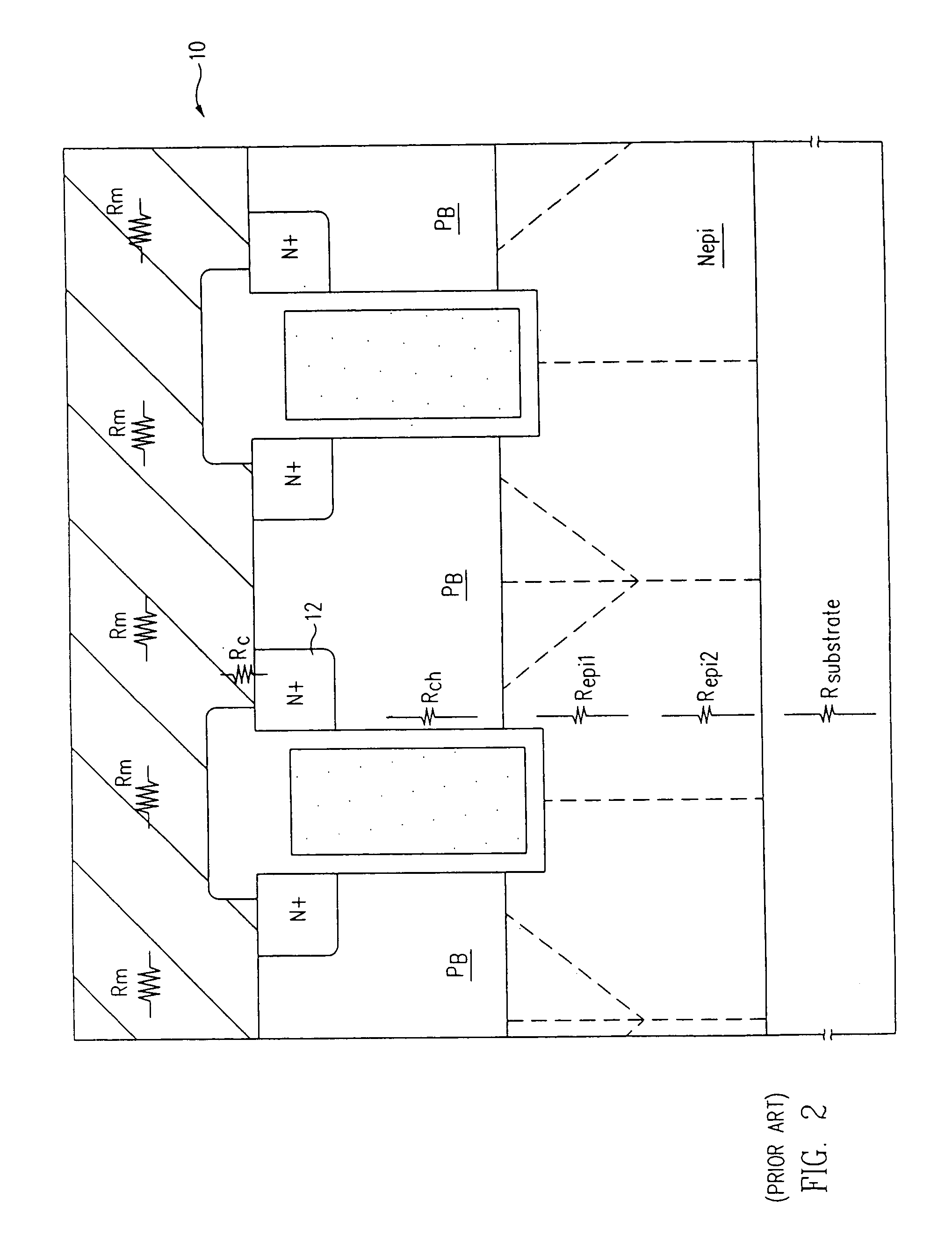1. The
metal resistance is minimized through the use of a thicker
metal layer.
2.
Grinding the
wafer to the thinnest possible dimension minimizes the substrate resistance. The
grinding must be performed near the end of the fabrication process so that the risk of breakage from handling is minimized.
3. There is an unavoidable tradeoff between the
avalanche breakdown voltage and the on-resistance of the device. Higher breakdown voltages require thicker, more lightly doped epitaxial
layers contributing higher epitaxial resistances. Generally, the
doping of the epitaxial layer is chosen so as to provide the most highly-doped layer capable of supporting the required off-state blocking
voltage (i.e., its specified
avalanche breakdown voltage).
4. The channel resistance is minimized by maximizing the channel perimeter for a given area. The individual cells of the
MOSFET may be constructed in any striped or polygonal shape. Ideally, the shape chosen should be one that can be repeated at a regular
pitch so that more cells can be connected in parallel in a given area. Paralleling many cells and operating them in tandem can achieve an extremely low on-resistance.
5. Higher
cell densities have the
advantage that the current in the epitaxial drain becomes uniform closer to the surface, more fully utilizing the epitaxial layer for conduction and reducing the spreading resistance term (Repi1) of the epitaxial resistance. As may be seen be by comparing FIG. 3A with FIG. 3B, a smaller
cell pitch reduces the area wasted where no current flows, conducting current uniformly through a greater percentage of the
total thickness of the epitaxial layer. The more uniform conducting epitaxial layer exhibits a lower
drain resistance.
This circumstance is difficult to achieve in practice, especially in narrow
trench gate designs where the alignment tolerances needed to form the source and
body regions and to establish a contact to them leads to a wide mesa.
The presence of a source at the square corners in an array of trench-gated DMOS cells has been found to lead to off-state leakage in the device, possibly due to defects along the trench corners or some enhanced
diffusion of the source along the corners.
Unfortunately, this corner block feature reduces the gate perimeter of the device and increases channel resistance.
Furthermore, as the
cell is scaled to smaller dimensions it becomes impractical to continue to employ the corner block concept since the corners become too close together.
The reduction of source perimeter becomes substantial in such a case and the contact area of the source also suffers.
Despite some claims to the contrary in commercial and industry trade magazines, the packing density of hexagonal cells is no better then the conventional square
cell design, resulting in exactly the same A / W.
As photomasking equipment now used exclusively for
microprocessor and
DRAM manufacturing becomes available for power
semiconductor production, the trench width SLD is likely to shrink.
Below a mesa width of around 0.9 to 1.1 μm, even
fine line contacts and accurate layer-to-layer alignments become difficult.
Moreover, at these dimensions, other manufacturing-related problems exist.
Many commercial power MOSFETs today are inadequate in this regard and suffer from
snapback and ruggedness problems as a result.
Whenever a small contact feature is used to achieve a small mesa and
high cell density, another problem occurs with respect to the step coverage of the metal contact.
But the resistance of a
thin metal layer, especially under 1.2 μm thick, is too high to be useful in a power device.
Since all of the current must flow through the
thin metal and over the step, the device still exhibits high metal resistance and also suffers from poor
electromigration performance, despite the thick
metal deposition.
The metal step coverage problem occurs anywhere in the die where the source metal crosses the
polysilicon gate bus, because the surface polysilicon is too thick.
The thick polysilicon also limits the possible manufacturing process sequence because the polysilicon is too thick to introduce dopants through it.
To summarize, one problem with existing conventional trench-gated vertical DMOS devices is that the
cell density cannot be increased and the geometric-area-to-gate-perimeter ratio cannot be further reduced to produce improvements in the area efficiency of low-on-resistance switches, since the construction of conventional trench-gated vertical DMOS imposes fundamental restrictions in cell dimensions.
The resistance penalty is especially significant for
low voltage devices where a large portion of the
total resistance is attributable to the resistance of the MOS channel (Rch).
The limitations on
cell density are primarily a consequence of the minimum width of the mesa between trenches.
Stripe geometries reduce or eliminate the need for frequent or large area abutting source / body shorts, allowing tighter cell pitches but potentially creating problems in achieving good breakdown and
snapback characteristics.
But without pushing the design rules to the point where the width of the mesa equals the width of the gate trench, the A / W of the stripe geometry is inferior to the A / W of a square
cell geometry having a similar cell
pitch.
 Login to View More
Login to View More  Login to View More
Login to View More 


